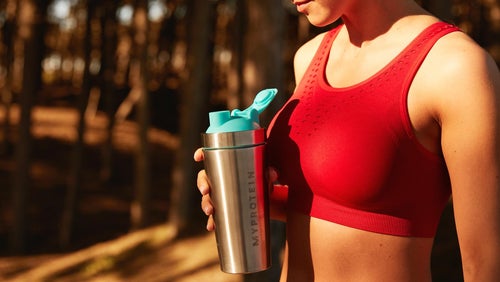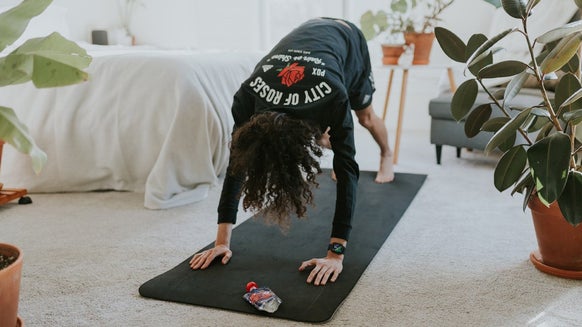Fasted Cardio: What Is It & What Are The Benefits?

Are you trying to cut down on body fat and not seeing enough success? Are you typically an early riser who prefers to get your workout done in the morning? Are you practicing intermittent fasting, or can you wake up without immediately feeling hungry? If so, fasted cardio might be a good training option for you. This type of training could make your body adapt to target fat for energy and lead to overall changes in body composition.
What is Fasted Cardio?
The idea of fasted cardio is performing a cardio workout without eating a meal or snack first. Most of the time, fasted cardio occurs in the morning with a “fast” of not eating for the past 6-10 hours prior. While some athletes swear by fasted cardio for fat lass, others find it difficult. Here’s the evidence for and against fasted cardio, which will let you decide if it’s a strategy worth trying.

Why does fasted cardio burn fat?
When you exercise, your body’s first choice of fuel is carbohydrates — after you eat carbs, your body has glucose (the building blocks of carbs) available in your blood stream and muscles for energy. Long, intense cardio sessions burn through the available glucose and then start to burn stored energy (muscle glycogen).
Weight loss happens when you burn more calories than you consume — the reason why most of us do cardio. However, targeting fat to burn instead of carbs (the body’s preferred energy source) can be tricky. The theory behind fasted cardio is to work at a level that’s less intense so that when glucose isn’t readily available, the body starts to break down stored fat for energy instead.1 It can be a difficult balance to get your body to burn stored fat for fuel instead of breaking down stored glycogen or muscle.
What are the benefits?
1. Burning stored energy – fat
Normally, people want to try fasted cardio because they think that working out without eating beforehand forces your metabolism to adapt. However, the type and intensity of exercise being performed also has an impact on the way that your body chooses to fuel your workouts. The ideal conditions for fat burning include having no recently ingested glucose (no food in the last 4-8 hours) and not working at an intensity high enough to damage/break down muscle tissue.2
2. Works with intermittent fasting
Intermittent fasting, or eating only during a short window of time throughout the day, means that a morning workout would most likely occur during a fasting period. While there are many different types of intermittent fasting and research is being conducted on all of its potential benefits and side effects, fasted cardio would easily fit into many of these plans.
3. Can be done immediately upon waking
There is no better benefit of fasted cardio than the fact that you eliminate the time it takes to consider fuelling for your workout. Typically, you want to wait about 30 minutes after eating to start working out, which means if your goal is a 6am workout, you have to finish your morning meal before 5:30. With fasted cardio, you don’t have to wake up earlier to make a pre-workout meal or snack, you don’t even have to chug a protein shake — just get straight to your workout and worry about the nutrition after.
Fasted Cardio for Fat Loss / Weight Loss
So, does fasted cardio REALLY work for fat- and weight loss? As with most bodybuilding and exercise strategies, it depends. While research supports that idea that more fat is burned without carbohydrates in our digestive system, it might be difficult to have enough energy for your running, biking, or elliptical session.1 If you like to push yourself to the max or do long periods of intense cardio exercise, your body will likely not perform as well when it has to focus on breaking down fat for energy. It may also shift into breaking down muscle.
If your go-to workout is low- to moderate-intensity cardio, fasted cardio is a small tweak to your normal routine. You might still be able to fit in fasted cardio if you find it difficult to wake up early in the morning, as you could even perform this type of a workout 6 hours after your last meal — between lunch and a late dinner, for example. As long as your previous meal has been digested and absorbed, the glucose levels and insulin in your blood should be low enough for your body to call upon its fat stores for energy.
Studies have shown that regularly training fasted makes your body become even more efficient at burning fat for fuel over time.2 Without readily available glucose for energy, your cells are forced to adapt to get the energy that they need. That means fat is used when you train at the right cardio intensity.

Is Fasted Cardio Safe?
Unless you have blood sugar control issues that would make it unsafe to exercise without a proper meal or snack, it’s typically safe for most people to perform a low to moderate intensity fasted cardio workout.1 Most training plans have “active recovery” or moderately light cardio days built in, which are good opportunities for trying fasted cardio.
However, if you want to attack high intensity interval training or long-distance training runs, swims, or bike rides, it’s best to schedule those during times when you are properly fuelled. Intense workouts like these often require additional nutrition during training in addition to a high carbohydrate pre-workout meal. Long bouts of cardio exercise put so much demand on our muscles that they need both readily available glucose (carbohydrates) and stored energy (in the form of glycogen), that you get from fuelling properly for the days and weeks beforehand.
Research has shown that proper pre-workout nutrition is key to optimising your performance for activities like weightlifting and other high-intensity, short-duration exercise.1 If you go above the recommended low intensity (about 50-60% of your target heart rate) during fasted cardio, you run the risk of burning muscle instead of fat during your workout, in addition to not being able to perform well.
Is Fasted Cardio for Me?
So how can you decide if you want to try fasted cardio? When you’re struggling to see changes in your body composition or lose those last few stubborn pounds, it could be a suitable option to try. Adding fasted cardio workouts at a low to medium intensity in addition to your regular workout schedule might be the boost that you need to see some results. As with all training regimens, keep track of how you feel during and after your workout so you can adapt and find what works best for you.
Easier workouts that lightly elevate your heart rate are the best options for fasted cardio. Workouts like easy elliptical work, yoga, Pilates, easy cycling, or a light jog would be good options. Not only do higher intensity workouts take your heart rate out of the fat burning zone, they can also make you feel light headed or weak without having any fuel beforehand.
When might fasted cardio not be for you? Anyone who has blood sugar control issues (like diabetes or hypoglycaemia) or has to eat first thing in the morning due to any other medical condition should talk to their doctor before trying fasted cardio.
If you find yourself starving all day after a fasted cardio workout, you might end up overeating later in the day, making your effort pointless. Some research studies found that subjects were unsuccessful for this reason. The timing and type of your post-workout refuelling can help to limit this — choose foods high in protein and fibre to keep you feeling satisfied.
Often, burning fat for energy without a carbohydrate source can make us crave more calories for refuelling, so choose your post workout snack carefully (and quickly) and get balanced nutrition through the rest of the day. Make sure you include plenty of protein just in case your muscles were overly stressed by the fasted cardio workout.
Take Home Message
Remember, no matter whether you choose to do cardio in a fasted or fed state, a daily calorie deficit is the key to burning fat and losing weight. If you have the time and discipline to add in a few days of low intensity morning workouts without eating beforehand, this strategy can be worth a try. Fasted cardio might be the extra effort you add to your training plan that makes a noticeable difference in your results. However, make sure that you are not overeating to compensate for your workout.
READ THIS NEXT:

10 Quick Post-Workout Snacks To Fuel Your Muscles
Prevent hunger-fuelled rampages with these on-the-go snacks.

How To Get Up Early For A Workout
Exactly how to start your day strong.

Claire is a Registered Dietitian through the Academy of Nutrition and Dietetics and a board-certified Health and Wellness Coach through the International Consortium for Health and Wellness Coaching. She has a Bachelor of Science in Biology and a Master’s degree in Clinical Dietetics and Nutrition from the University of Pittsburgh.
Talking and writing about food and fitness is at the heart of Claire’s ethos as she loves to use her experience to help others meet their health and wellness goals.
Claire is also a certified indoor cycling instructor and loves the mental and physical boost she gets from regular runs and yoga classes. When she’s not keeping fit herself, she’s cheering on her hometown’s sports teams in Pittsburgh, or cooking for her family in the kitchen.
Find out more about Claire’s experience here.






